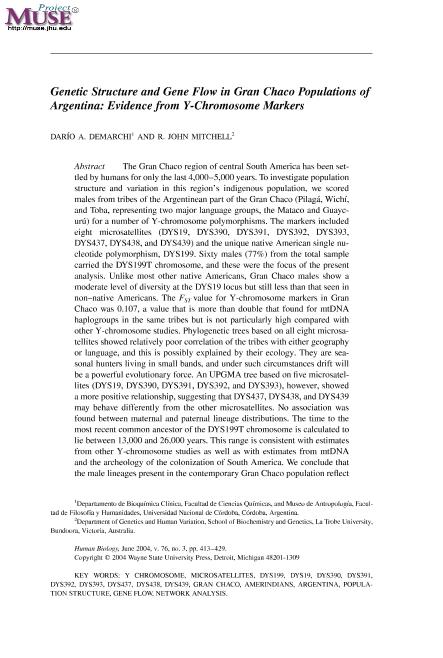Mostrar el registro sencillo del ítem
dc.contributor.author
Demarchi, Dario

dc.contributor.author
Mitchell, R. John
dc.date.available
2021-05-17T20:12:05Z
dc.date.issued
2004-12
dc.identifier.citation
Demarchi, Dario; Mitchell, R. John; Genetic structure and gene flow in Gran Chaco populations of Argentina: Evidence from Y-chromosome markers; Wayne State University Press; Human Biology; 76; 3; 12-2004; 413-439
dc.identifier.issn
0018-7143
dc.identifier.uri
http://hdl.handle.net/11336/132185
dc.description.abstract
The Gran Chaco region of central South America has been settled by humans for only the last 4,000-5,000 years. To investigate population structure and variation in this region's indigenous population, we scored males from tribes of the Argentinean part of the Gran Chaco (Pilagá, Wichí, and Toba, representing two major language groups, the Mataco and Guaycurú) for a number of Y-chromosome polymorphisms. The markers included eight microsatellites (DYS19, DYS390, DYS391, DYS392, DYS393, DYS437, DYS438, and DYS439) and the unique native American single nucleotide polymorphism, DYS199. Sixty males (77%) from the total sample carried the DYS199T chromosome, and these were the focus of the present analysis. Unlike most other native Americans, Gran Chaco males show a moderate level of diversity at the DYS19 locus but still less than that seen in non-native Americans. The FST value for Y-chromosome markers in Gran Chaco was 0.107, a value that is more than double that found for mtDNA haplogroups in the same tribes but is not particularly high compared with other Y-chromosome studies. Phylogenetic trees based on all eight microsatellites showed relatively poor correlation of the tribes with either geography or language, and this is possibly explained by their ecology. They are seasonal hunters living in small bands, and under such circumstances drift will be a powerful evolutionary force. An UPGMA tree based on five microsatellites (DYS19, DYS390, DYS391, DYS392, and DYS393), however, showed a more positive relationship, suggesting that DYS437, DYS438, and DYS439 may behave differently from the other microsatellites. No association was found between maternal and paternal lineage distributions. The time to the most recent common ancestor of the DYS 199T chromosome is calculated to lie between 13,000 and 26,000 years. This range is consistent with estimates from other Y-chromosome studies as well as with estimates from mtDNA and the archeology of the colonization of South America. We conclude that the male lineages present in the contemporary Gran Chaco population reflect the level of diversity found in South America and that the region's male founders did not carry a restricted gene pool.
dc.format
application/pdf
dc.language.iso
eng
dc.publisher
Wayne State University Press

dc.rights
info:eu-repo/semantics/openAccess
dc.rights.uri
https://creativecommons.org/licenses/by-nc-sa/2.5/ar/
dc.subject
AMERINDIANS
dc.subject
ARGENTINA
dc.subject
GENE FLOW
dc.subject
GRAN CHACO
dc.subject
MICROSATELLITES
dc.subject
NETWORK ANALYSIS
dc.subject
POPULATION STRUCTURE
dc.subject
Y CHROMOSOME
dc.subject.classification
Antropología, Etnología

dc.subject.classification
Sociología

dc.subject.classification
CIENCIAS SOCIALES

dc.title
Genetic structure and gene flow in Gran Chaco populations of Argentina: Evidence from Y-chromosome markers
dc.type
info:eu-repo/semantics/article
dc.type
info:ar-repo/semantics/artículo
dc.type
info:eu-repo/semantics/publishedVersion
dc.date.updated
2021-04-23T17:05:54Z
dc.journal.volume
76
dc.journal.number
3
dc.journal.pagination
413-439
dc.journal.pais
Estados Unidos

dc.journal.ciudad
Detroit
dc.description.fil
Fil: Demarchi, Dario. Consejo Nacional de Investigaciones Científicas y Técnicas. Centro Científico Tecnológico Conicet - Córdoba. Instituto de Antropología de Córdoba. Universidad Nacional de Córdoba. Facultad de Filosofía y Humanidades. Instituto de Antropología de Córdoba; Argentina
dc.description.fil
Fil: Mitchell, R. John. La Trobe University; Australia
dc.journal.title
Human Biology

dc.relation.alternativeid
info:eu-repo/semantics/altIdentifier/doi/https://doi.org/10.1353/hub.2004.0043
dc.relation.alternativeid
info:eu-repo/semantics/altIdentifier/url/https://muse.jhu.edu/article/171639
Archivos asociados
